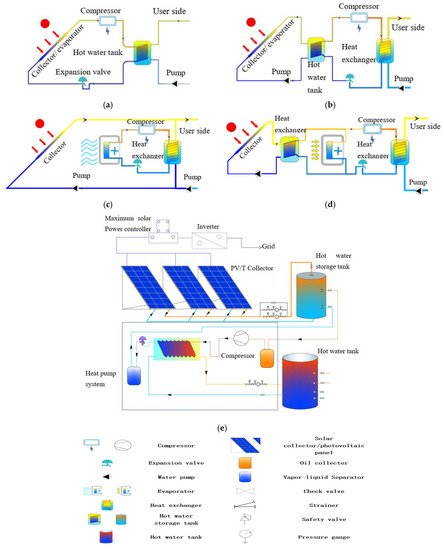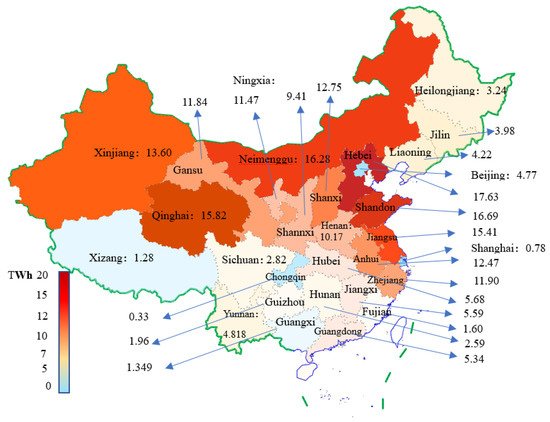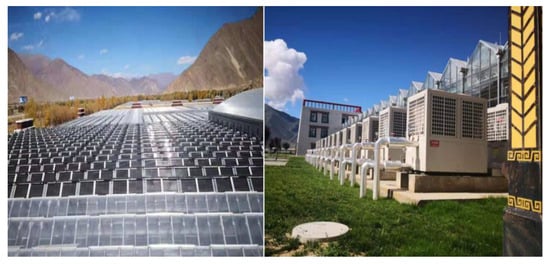Your browser does not fully support modern features. Please upgrade for a smoother experience.
Please note this is an old version of this entry, which may differ significantly from the current revision.
Subjects:
Construction & Building Technology
The building sector accounts for over 40% of global energy consumption. The utilization of renewable energy systems such as the solar-assisted heat pump (SAHP) in buildings has been shown to improve building energy efficiency and achieve carbon neutrality.
- solar-assisted heat pump (SAHP)
- energy efficiency
- research and development
1. Research on the Types of Heat Pumps
SAHP technology is an effective combination of solar collectors and traditional heat pumps. The SAHP is based on the transformation of the heat exchanger of the traditional heat pump by utilizing solar energy as the heat source, or combined with other energy sources, to improve the coefficient of performance of the heat pump. From the ways of solar energy utilization, SAHP systems can be divided into photovoltaic-solar-assisted heat pumps (PV-SAHP), photothermal-solar-assisted heat pumps (PT-SAHP), and photovoltaic/thermal-solar-assisted heat pumps (PV/T-SAHP).
The PV-SAHP systems can be divided into direct solar-assisted heat pumps (DX-SAHP), indirect solar-assisted heat pumps (IX-SAHP), and PV/T-SAHP systems, according to the different connection methods and heat collection media. In the DX-SAHP system, the refrigerant flows into the solar collector directly and is heated. The collector is the heat source for evaporation. In the IX-SAHP system, the solar collector and the heat pump evaporator operate independently, and heat is absorbed through a heat exchanger. According to the differences in the connection between the solar heat collection cycle and the heat pump cycle, they can be classified as series, parallel, and dual heat source heat pumps [39,40]. The PV/T-SAHP system simultaneously utilizes solar energy, electric energy, and other forms of ambient energy. PV/T modules are used as a heat collection evaporator combined with an SAHP cycle to realize the comprehensive utilization of solar energy, photoelectricity, and heat, and improve the overall efficiency of the heat pump system [41]. The PV/T system will be one of the focuses of future research.
Table 1 lists the main components for the different types of SAHP systems.
Table 1. Classification and system components of SAHP systems.
| Classification | System Components | Ref. |
|---|---|---|
| PV-SAHP | PV evaporator (photovoltaic and heat pump evaporation), photovoltaic conversion device (inverter), auxiliary evaporator, heat pump system (evaporator, condenser, compressor, expansion valve), public grid, building heating, and domestic hot water system. | [39] |
| DX-SAHP | Solar collector, heat exchanger, pump, heat pump system (evaporator, condenser, compressor, expansion valve), domestic hot water system, and hot water storage tank (optional). | [40] |
| IX-SAHP (Series) |
Flat plate collector, compressor, condenser, evaporator, expansion valve, pump, and domestic hot water system. | [42] |
| IX-SAHP (Parallel) |
Flat plate collector, compressor, condenser, expansion valve, water pump, hot water inlet, hot water outlet, evaporator, and hot water tank. | [42] |
| IX-SAHP (Hybrid) |
Flat plate collector, compressor, condenser, evaporator, expansion valve, water pump, hot water inlet, and hot water outlet. | [42] |
| PV/T-SAHP | Solar air collector (photovoltaic module, heat absorption plate, airflow channel, edge and back insulation layer, metal frame), compressor, hot water storage tank with a built-in condensing coil, and expansion valve. | [41] |
The SAHP system combines solar energy utilization and building energy supply through the heat pump cycle. In the DX-SAHP system, the refrigerant flows directly through the collector/evaporator and then passes through various components such as the compressor to complete a cycle [39]. For IX-SAHP, the solar collector absorbs heat and transfers it to the system evaporator through the heat exchanger. The refrigerant absorbs heat in the evaporator, evaporates, and then passes through the compressor, condenser, and throttle valve to complete a cycle [42]. Compared with IX-SAHP, the application of the collector in the DX-SAHP system makes the system structure more simplified and compact for the following reasons: (1) the refrigerant in the solar collector directly absorbs heat and vaporizes, leading to higher thermal performance; (2) at the same time, the working fluid in the collector is refrigerant instead of water, which can prevent the freezing problem of solar collectors on cold nights [39]; (3) for the collector, the refrigerant absorbs heat and evaporates in the collector, which can maintain a low collector temperature and effectively improve the efficiency of the collector. The disadvantage of DX-SAHP is that the thermal performance of the system is closely related to the change in solar radiation intensity. As the daily solar radiation intensity can vary from 0 W/m2 to 800 W/m2, the thermal performance of the system fluctuates greatly [43]. Figure 8a–d display the system diagrams for DX-SAHP and IX-SAHP in series, parallel, and hybrid connections. In a series system, the solar collector and the heat pump evaporator are connected in series and exchange heat through an intermediate medium. In the parallel system, the solar heat collection system and the heat pump system are connected in parallel, and both can produce hot water [43]. Figure 8e presents the system diagram of a PV/T-SAHP system. Compared with normal photovoltaic-assisted solar heat pumps, the PV/T systems address both the cooling need of photovoltaic modules and the heat absorption need of the evaporator. The solar energy utilization efficiency is significantly improved when the photoelectric and photothermal conversions are carried out at the same time. In addition, the working temperature of the photovoltaic cell is decreased, and the photoelectric efficiency is increased. As the heat source of the heat pump, the PV/T heat collection module increases the evaporation temperature and evaporation pressure of the working fluid of the evaporator so that the coefficient of performance of the heat pump can be improved [44].

Figure 8. Different types of SAHPs. (a) Schematic diagram of DX-SAHP; (b) Series connection of IX-SAHP; (c) Parallel connection of IX-SAHP; (d) Hybrid connection of IX-SAHP; (e) PV/T-SAHP [43].
Based on the above survey of the literature, it can be concluded that the coupling of solar energy and other heat sources needs to take advantage of the abundance of energy sources in the specific region. This is because multi-energy-source heat pumps usually have higher COPs than that of single-source heat pumps. Few papers have focused on the intelligent control of the SAHPs; although, it is very important to match the dynamic user demand and achieve energy saving in practice. More studies are needed to optimize the capacity matching among all the components of the heat pump to achieve high system energy efficiency.
2. Research on the Performance of SAHP
Different commercially available software and programming language have been used by scholars to conduct simulations of the performance of the SAHP system, among which TRNSYS was most favored by the researchers due to its ability to dynamically simulate the annual building thermal load, heating/air conditioning system operation, solar energy system, ground source, hybrid connection SAHP performance, etc.
Figure 11 lists the simulation platforms/programming languages adopted by the researchers. It can be found that a large proportion of the computer models were developed under the TRNSYS/MATLAB environment. TRNSYS is most favored by researchers for whole system performance analysis, while MATLAB is welcome for analyzing the operating characteristics of a certain component in the SAHP system and the dynamic energy performance under different environmental conditions. The CFD software, such as ANSYS and Fluent, is used to perform analysis of indoor thermal and humidity environments.

Figure 11. Simulation platforms/programming languages adopted by the researchers.
From the literature survey, it can be concluded that current studies focus on whole system operation performance or component level simulation, or indoor environmental condition analysis. Few studies have been conducted to investigate the optimal control strategies and their impact on indoor thermal and humidity, which could be the future direction of research.
3. Application of SAHP
The application of SAHP in a certain region is related to the solar power generation capacity in that region. Figure 12 presents the solar power generation by region in China in 2019. It can be observed that solar power generation concentrates in the northwest, east coast, and north China regions. The solar power generation in the northern region of China (north of Qinling and Huaihe River) is much higher than that in the southern region, which could be due to the better local solar energy resources and more supportive government policies in northern regions. As a result, more SAHP projects were developed in northern regions. Table 8 lists the representative SAHP projects in China since 2001 that have been implemented and put into operation. The projects were selected from the national and local government official websites. Those local renewable demonstration projects have been completed and put into operation with proven energy-saving data and benefits. These projects demonstrate innovation and economic and environmental protection benefits compared with traditional projects.

Figure 12. Solar power generation by region in China in 2019 (TWh) [3].
Figure 13 and Figure 14 provide an overview of the Beijing Daxing Village Household Solar Energy + Air Source Heat Pump Heating Retrofit Project and the Solar + Water Source Heat Pump Heating Project of Caina Township Government, respectively.

Figure 13. Overview of the Beijing Daxing Village Household Solar Energy + Air Source Heat Pump Heating Retrofit Project [113].

Figure 14. Overview of the Solar + Water Source Heat Pump Heating Project of Caina Township Government [114].
The above projects point out that in regions with sufficient radiation during the heating season, DX-SAHP is suggested for seasonal heating. In regions with sufficient annual irradiation throughout the year, it is advisable to use solar heating assisted with a dual-source heat pump for heating. In cold regions that required heating most of the time in the year and with insufficient radiation, a combination of a non-direct expansion heat pump system with thermal storage technology as an auxiliary heat source is recommended. Furthermore, most projects are implemented in coastal areas in the east and inland areas with moderate solar energy resources and developed economies. Although solar energy resources are abundant in the northwest regions, southwest regions, and Tibetan regions, very few SAHP projects could be found in these regions. Therefore, to help reach carbon peak and carbon neutrality, it is recommended to promote SAHP projects in these regions.
4. Regulations, Standards, and Policies Related to SAHP
The solar energy industry is part of both the renewable energy industry and the energy-saving industry. Currently, the regulations, standards, and policies for SAHP mainly focus on solar thermal utilization and water heaters. Compared with large-scale solar heat collection projects, the standards and technical regulations of different types of SAHPs and hot water systems still need improvement. It is also important to increase the formulation and implementation of economic policies for SAHPs [116].
4.1. Regulations and Standards for SAHP in China
It can be seen that early regulations mostly focused on solar energy hot water systems due to their easy installation. “Technical specification for solar photovoltaic and thermal heat pump system (T/CECS 830-2021)” [117] is the first relatively complete technical regulation on the utilization of SAHP in the past ten years. In addition, the mandatory policies of relevant laws and regulations on SAHPs mainly focus on solar thermal utilization.
With the proposal of new national strategies for reaching carbon peak and carbon neutrality, a complete technical specification and design standard is needed for solar thermal utilization and SAHP application to support and promote the extensive application of SAHPs in China. In addition, there are very few mandatory policies for solar energy and heat pump engineering technology. Therefore, in the future development of SAHPs, the government still needs to formulate and improve relevant laws and regulations and develop practical guidelines for implementation accordingly.
4.2. Government Financial Subsidy Policy for Solar Industry
The solar photovoltaic industry in China has great development potential with policy-based financial support and market-based financial support. However, due to the high investment risk and uncertain yield in the renewable energy market, market-based financial support is not yet mature enough. Therefore, setting up economic policies that can provide guidance and incentives to the solar energy industry is very important at the early stage [125]. For example, the average photovoltaic power generation cost is about six times that of thermal power. However, among all primary energy sources, the proportion of solar power generation energy has steadily increased. By 2020, the annual solar energy utilization nationwide reached over 1.140 × 108 tons of equivalent standard coal [126]. From 2012 to 2021, the proportion of solar power generation increased from 0.07% to 4% of the total national power generation [127].
The SAHP industry belongs to the new energy industry and renewable energy industry, and the government has been providing special subsidies to solar photovoltaic cells and modules [128]. Article 25 of the “Renewable Energy Law of the People’s Republic of China”, revised in 2009, states that the renewable energy development and utilization projects listed in the National Renewable Energy Industry Development Guidance Catalog are eligible for loan application and can receive financial assistance with discounted loans from financial institutions [26].
Financial subsidies for the solar energy industry mainly include subsidies for initial investment, on-grid tariffs, and financial subsidies for technology research and development and personnel training in the photovoltaic industry. The subsidy policies come from many different ministries, such as the National Development and Reform Commission, Energy Administration, and China Development Bank, and the subsidies are not unified [129].
In addition to the central government’s subsidies, local governments have also introduced a large number of relevant subsidy policies to encourage the development of the solar industry, which are added to the national subsidies. The subsidies offered by the local governments can be mainly divided into power demand/consumption subsidies and one-time investment subsidies. With the support from the subsidies, the Return On Investment (ROI) of distributed photovoltaic power generation projects can be significantly improved [125].
The number of subsidies from the state and local governments provided to the solar energy industry, especially the photovoltaic industry, is steadily increasing. At the same time, with the national macro policy, the supporting photovoltaic policies in local regions are more active. However, due to poor project supervision and the low entry barrier of this industry, there have been problems such as fraudulent subsidies and fake projects that disrupt the market order, which discourage the enthusiasm of the enterprise [139]. Therefore, financial subsidies for the solar energy industry should move reasonably towards investment subsidies, electricity price subsidies, and consumption subsidies in order to stimulate and develop the clean energy consumption markets [132].
4.3. Fiscal, Tax, and Financial Policies for the Photovoltaic Industry
In terms of income tax, the National Development and Reform Commission has added solar photovoltaic products to the “National Environmental Protection Industry Equipment Product Catalog” which was released in 2010. With this, relevant enterprises can enjoy tax reductions and exemptions in terms of investment credits and accelerated depreciation for equipment [116]. For Value-Added Tax (VAT), when the scale of distributed photovoltaic power plants is small and the monthly online sales revenue is less than CNY 20,000, VAT is exempt. When the annual sales revenue exceeds CNY 500,000, VAT must be paid. According to the notice of the PV power VAT policy issued by the Ministry of Finance and the State Taxation Administration, taxpayers can enjoy a 50% refund of VAT immediately after collection, and enterprises can be exempt from a certain percentage of income tax within a certain period of time [129].
In recent years, the China Development Bank has provided various support for distributed photovoltaic project implementation [125]. The financing methods for solar photovoltaic enterprises mainly include equity financing, debt financing, policy financing, financial leasing, internet crowdfunding, internet wealth management and third-party financing [140], among which bank loans are the primary financing method. In terms of policy financing, the China Development Bank is the leading provider for the new energy industry [141]. As of August 2013, the China Development Bank has provided loans of CNY 4.105 × 1011 to photovoltaic solar energy, and the Bank of China offered CNY 3.01 × 1012 green finance in 2014, mainly to support wind power and solar photovoltaic industry [142]. As of March 2017, a total of 60 banks across the country have launched “photovoltaic loans” to support the development of the photovoltaic industry, mainly from Zhejiang, Jiangsu, Jiangxi, Shandong, Shanxi Province, etc. [143].
Multiple guidelines and policies have been issued for the use of clean energy in building design and renovation in a number of domestic provinces and cities. For example, the economic policies issued in Hubei, Shandong, and other provinces and cities provide guidance on projects related to solar energy + “multi-energy complementary heat utilization”, cooling, heating, electricity trigeneration, solar/air source energy, ground source, and other clean energy sources.
This entry is adapted from the peer-reviewed paper 10.3390/buildings12091435
This entry is offline, you can click here to edit this entry!
